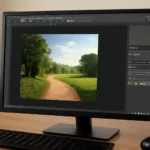Want to master seamless edits in Photoshop without permanently altering your image? Curious how professionals isolate details or blend layers with pixel-perfect precision? This guide walks you through everything you need to know about the Photoshop layer mask—from what it is, to its powerful functions, to advanced modification tips you won’t find elsewhere.
Photoshop layer mask
If you’ve ever wondered how to make clean, non-destructive edits in Adobe Photoshop, the answer often lies in layer masks. A layer mask allows you to control the visibility of different parts of a layer using grayscale values—white reveals, black conceals, and gray partially shows.
The key benefit? You don’t delete anything. Instead, you hide or show parts of your layer with incredible flexibility. This is essential for photo composites, retouching, exposure blending, and more.
Understanding the Basics
Here’s a simplified breakdown of how layer masks work:
-
White on the mask 100% visible.
-
Black on the mask 100% transparent.
-
Gray on the mask Semi-transparent depending on the shade.
You can add a mask by clicking the mask icon at the bottom of the Layers panel. Once applied, just paint on the mask using a brush tool with black or white.
Real-World Example: Portrait Editing
Let’s say you want to brighten a subject’s face without affecting the background. Instead of selecting and duplicating layers, you can:
-
Create a Brightness/Contrast adjustment layer.
-
Add a layer mask.
-
Fill the mask with black.
-
Use a soft white brush to paint over the face.
Boom. You’ve selectively adjusted brightness non-destructively.
A Brief History and Evolution
Layer masks were introduced in earlier versions of Photoshop, but they’ve become more powerful with recent updates:
-
Vector masks for sharper, shape-based edges.
-
Linked masks to keep alignment with specific layers.
-
Select and Mask workspace for precision masking using AI.
Want to experiment? Try blending two photos (like sky replacements). You’ll quickly see how intuitive masks can be.
더욱 자세히 알아보려면 아래 버튼을 클릭하세요.
👉Explore Photoshop Layer Masks👈
Photoshop layer mask function
Let’s dig into what a Photoshop layer mask actually does under the hood. Its function isn’t just to “hide”—it’s a dynamic tool that manages pixel transparency and even layer adjustments in complex workflows.
Key Functions of a Layer Mask
Here are five vital functions you should know:
-
Selective Editing Apply changes only to specific parts of a layer.
-
Blending Layers Combine images with smooth, natural transitions.
-
Non-Destructive Workflow All edits are reversible.
-
Adjustment Layer Control Limit effects like brightness or saturation to selected areas.
-
Reusability and Copying Masks can be duplicated across layers or reused with tweaks.
Case Study 1: Sky Replacement
Imagine you’re editing a landscape photo with a dull sky. With a layer mask, you can:
-
Add a new sky on a layer above.
-
Create a mask and paint black over the original sky.
-
Blend the new sky perfectly into the scene.
Case Study 2: Color Grading
Say you’re color-grading a cinematic shot. Use Hue/Saturation layers with masks to:
-
Boost colors of just the subject’s clothing.
-
Desaturate the background.
-
Highlight only the eyes in a portrait.
This level of control is why masks are essential in Hollywood-style post-production.
Extra Tip: Using Gradients on Masks
Instead of brushing, try using gradients. For example:
-
Apply a black-to-white gradient on a mask to create a seamless transition.
-
Useful for vignettes, light effects, or blending textures.
Want to elevate your edit game? Use mask density and feather controls (in Properties Panel) to fine-tune the visibility and softness of your mask edges.
더욱 자세히 알아보려면 아래 버튼을 클릭하세요.
👉Discover Photoshop Mask Functions👈
Photoshop layer mask modification
Once you’ve created a mask, that’s just the beginning. Knowing how to modify your Photoshop layer mask is what separates beginners from seasoned editors.
8 Smart Ways to Modify a Layer Mask
-
Brush Tool Adjustments Switch between black and white to refine visibility.
-
Feathering Softens the mask edges.
-
Invert Mask Use
Ctrl+I(Windows) orCmd+I(Mac). -
Link/Unlink Layers and Masks Allows free movement.
-
Copy Masks Hold
Alt(Windows) orOption(Mac) and drag the mask to another layer. -
Apply Filters Like blur for smoother transitions.
-
Mask from Selection Turn a selection into a mask.
-
Use Select and Mask Tool Great for hair and complex edges.
Case Study: Removing Backgrounds with Precision
Let’s say you’re cutting out a product for an ecommerce listing:
-
Use Select Subject.
-
Refine edges in the Select and Mask workspace.
-
Apply the selection as a mask.
-
Further adjust using brushes or gradient masks.
The result? A razor-clean cutout that’s still editable if the client changes their mind.
Case Study: Replacing Textures
Another example—replacing the skin texture on a model’s face while preserving lighting:
-
Add a high-resolution skin texture on a layer above.
-
Create a black-filled mask.
-
Carefully brush white over areas with blemishes.
-
Adjust opacity or feather for realism.
Modification is where layer masks become truly artistic. It’s not just editing—it’s sculpting light and form.
더욱 자세히 알아보려면 아래 버튼을 클릭하세요.
👉Learn Advanced Mask Modification👈
Conclusion
Mastering Photoshop layer masks is like learning to paint with light. From basic visibility toggles to complex composite manipulation, layer masks give you full creative control—non-destructively. As famed photographer Ansel Adams once said, “You don’t take a photograph, you make it.”
By understanding their function and learning how to modify them, you transform your workflow into a professional-grade editing process. Keep practicing, and soon masks will feel like second nature—quietly working behind the scenes to bring your vision to life.






